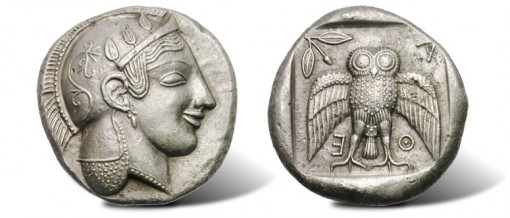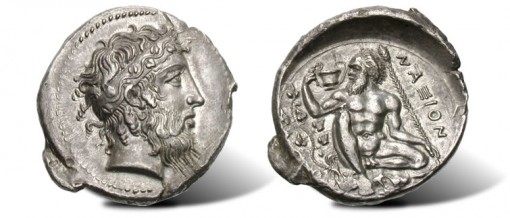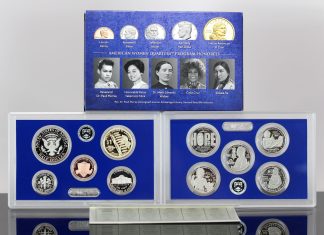A silver decadrachm of Athens struck 2,500 years ago, a silver tetradrachm of Naxos in Sicily struck circa 430 BC and a remarkable offering of Roman gold coins – spanning the history of the Empire – highlight the first joint auction held by Heritage Auctions and Gemini Numismatic Auctions, slated for April 14, 2011 during the Chicago International Coin Fair (CICF).

The joint Heritage-Gemini auction will include more than 552 Greek, Roman, Byzantine and medieval coins with individual estimates ranging from $500 to $875,000 and a cumulative estimated value of more than $3.5 million.
"We’re more than pleased to be conducting a joint auction with Heritage," said Harlan J. Berk of Chicago, president and co-founder of Gemini Auctions, along with B&H Kreindler of New York. "Herb and I have been friends with Heritage Co-Founders Steve Ivy and Jim Halperin, and with Warren Tucker, Heritage’s Vice President of World Coins, for more than 40 years and for that friendship to result in this event is beyond expectations."
"The paring of Gemini’s impeccable focus on quality and reputation with Heritage’s capabilities and marketing reach to nearly every collector in the world," said Steve Ivy, "should result in a special experience for everyone, but especially collectors."
The comprehensive collection of Roman gold coins consists of more than 50 gold aurei, ranging from a rare portrait issue of Julius Caesar, struck in 43 BC, to one of the last aureus issues of Constantine the Great, struck in AD 315.

"In a momentous year for ancient coin auctions, this event by the Heritage/Gemini partnership ranks among the very best," said David S. Michaels, Director of Ancient Coins for Heritage. "Roman gold is certainly the most active part of the ancients market, and seldom have so many important Roman gold pieces been offered in one auction." Among the rare Roman emperors and empresses represented in gold are Otho (two examples), Julia Titi, Matidia, Aelius, Diadumenian, Numerian, Helena, Magnus Maximus, a Eugenius tremissis in FDC and a facing portrait solidus of Licinia Eudoxia.
The auction also features an impressive offering of Roman silver denarii, including nearly 100 Roman Republican and Imperatorial silver pieces, many from a California collection formed in the 1950s and 1960s. The Roman silver selection features one of the finest known "Sulla’s dream" denarii, three portrait issues of Julius Caesar, an FDC Caesar "elephant" denarius, and a rare double-portrait issue of Augustus and Agrippa.

Among the Greek offerings, the single highlight is undoubtedly the Athenian silver decadrachm, an immense piece weighing more than 41 grams struck circa 469 BC in honor of a Greek naval victory over the Persians. The decadrachm, which depicts a helmeted head of Athena in sculptural high relief backed with the famous owl of Athens, its wings proudly spread, is among the most celebrated numismatic rarities in history.
"We believe this is the finest Athens decadrachm in existence," Berk said. "In choice extremely fine condition, the coin is perfectly centered and has none of the striking defects and metal problems usually associated with the issue." In keeping with recent auction prices of $500,000-800,000, achieved by the handful of Athens decadrachms sold since 1990, the coin will carry a pre-auction estimate of $875,000.
"The beautiful Athens decadrachm is by no means the only important Greek coin in the sale," said Michaels. "We also have two beautiful and seldom-offered Sicilian silver tetradrachms – one of Acragas and one of Naxos, that would normally be the highlight of any auction." The Naxos in particular is a masterpiece of classical art, featuring a finely struck portrait of the wine god Dionysus backed with the figure of the drunken satyr Silenus sipping from a wine cup. The tetradrachm is estimated at $185,000.
"Beyond this, we have a pedigreed collection of 13 silver staters of Elis, Olympia," Berk added. "Olympia, site of the ancient Olympic games, produced some of the most historically relevant and beautiful coins of antiquity."
The auction also includes the famous and finest example to come onto the market in decades of the "Discus-thrower" silver triple-siglos of Cos, issued circa 480 BC, and the finest known bronze portrait coin of Cleopatra VII, queen of Egypt and consort to Julius Caesar and Mark Antony.
A select group of coins from the Heritage-Gemini CICF auction goes back to the very dawn of coinage, featuring the earliest known coin type, a "striated" electrum third-stater of Lydia, circa 650 BC, along with a complete type set of "Lion scalp" electrum pieces from Miletos, circa 600-550 BC and a very important collection of inscribed Lydian trites and small electrums from that very rare series.
"This is the first time this has ever taken place," Berk noted.
The auction will begin at 6 p.m. on Thursday, April 14, the first day of CICF, held at the at the Crowne Plaza Chicago O’Hare Hotel and Convention Center, 5440 North River Road in Rosemont, IL.
Prior to the show, auction lot viewing will take place at the Dallas, New York and Beverly Hills offices of Heritage, and at the offices of Harlan J. Berk, 31 N. Clark Street in Chicago. Gemini Auctions can be found online at GeminiAuction.com.
About Heritage Auctions
Heritage Auctions, headed by Steve Ivy, Jim Halperin and Greg Rohan, is the world’s third largest auction house, with annual sales more than $600 million, and 500,000+ registered online bidder members. For more information about Heritage Auctions, and to join and gain access to a complete record of prices realized, along with full-color, enlargeable photos of each lot, please visit HA.com.






These Ancient Greek and Roman Coins look great to me! I wonder where these coins will be sold at? And any of these coins ever being sold at any coin dealers?
Sir,
i have two roman gold coins of Diva Faustina.
I would like to sell these.
Would be of great if you could help me out with some information .